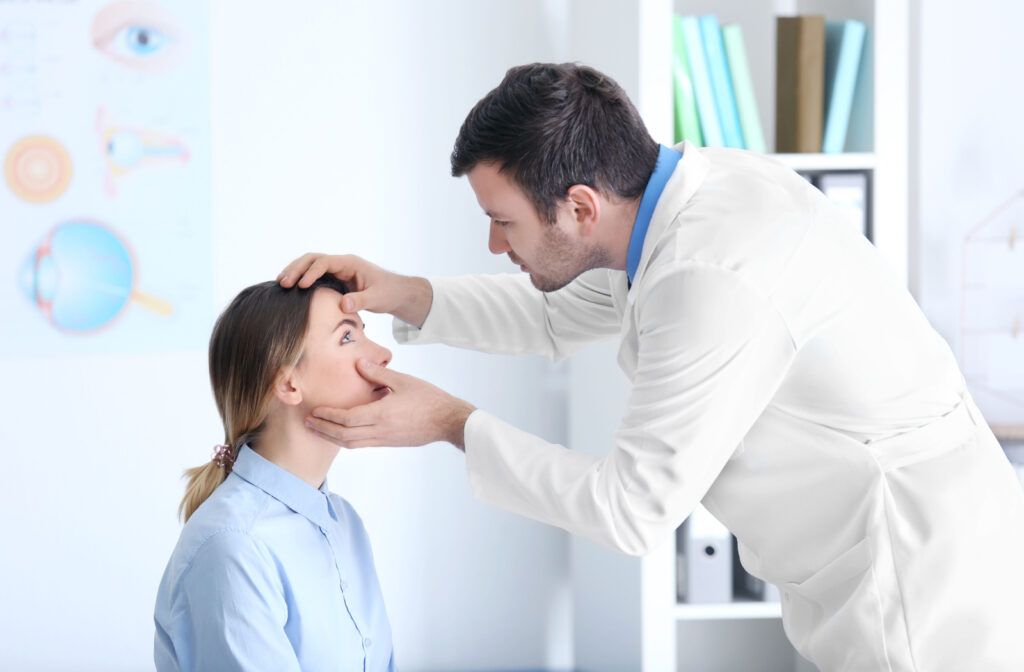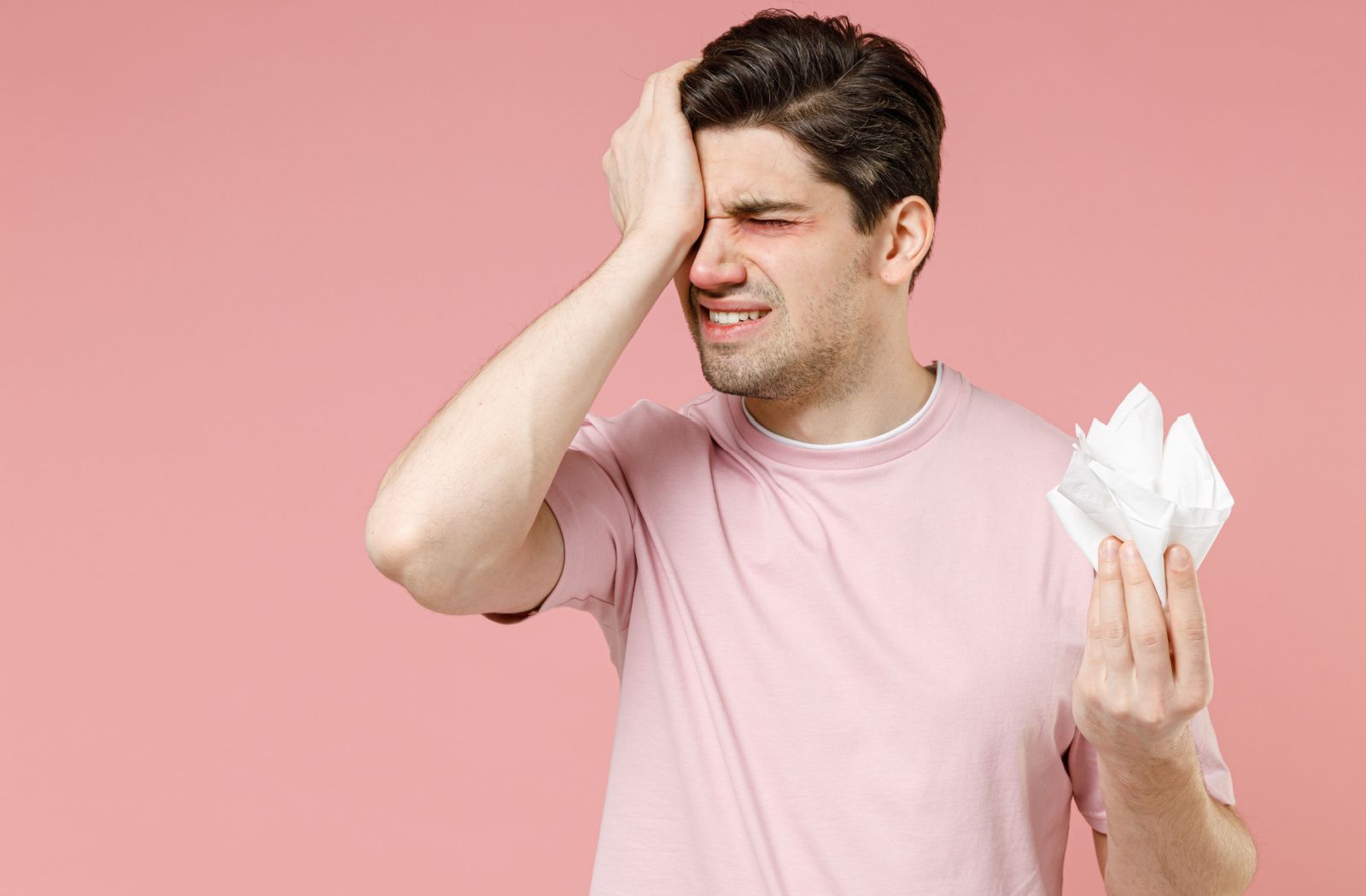We’ve likely all experienced red and scratchy eyes at some point in our lives. When it doesn’t go away, it can be alarming while you figure out what’s going on. Such as whether it’s a pink eye or a stye. Interestingly, though pink eye and a stye are 2 entirely different conditions, they might initially appear similar.
Pink eye is inflammation of the conjunctiva—the thin, clear layer that covers the eye’s white part— while a stye is an eyelid infection accompanied by a noticeable red bump. Fortunately, you don’t have to figure it out yourself; your optometrist can examine your symptoms and uncover the cause of your discomfort.
Pink Eye
Pink eye, also known as conjunctivitis, is an infection of the conjunctiva, the thin and transparent membrane that covers the eye surface and the inner eyelid. Additionally, pink eye can affect one or both eyes, or it may start in one eye and then spread to the other. Pink eye also tends to occur more commonly in children and can be accompanied by fever, sore throat, and respiratory problems.
Other pink eye symptoms include:
- Eye redness or pinkness
- Itching or burning
- Irritation
- Watery or sticky discharge
- Eyelid swelling
- Light sensitivity
Pink eye can be caused by viruses, bacteria, allergies, or chemical irritants, though only viral and bacterial pink eye are contagious. In viral or allergic conjunctivitis, the discharge is usually clear and watery, while in bacterial conjunctivitis, it tends to be thicker and yellow-green.
Treating Pink Eye
The correct treatment for pink eye depends on which strain you’re dealing with.
Bacterial pink eye treatment includes antibiotic eye drops or ointments your doctor prescribes. Viral pink eye can’t be treated with antibiotics, but will normally resolve on its own in a couple of weeks. Until then, you can focus on relieving painful symptoms. Try artificial tears or a cool, wet washcloth across your eyes. Just remember not to share your washcloth; viral pink eye is contagious! That’s why it’s also essential to practice good hand and face hygiene to help prevent the spread.
Antihistamines can help reduce allergic pink eye symptoms or may even prevent them entirely. Additionally, you can take steps to reduce your exposure to allergens by wearing sunglasses to block pollen or keeping your bedding clean to reduce dust mites.
Chemical pink eye is caused by irritants such as chlorine, smoke, or chemicals. If you’re exposed, wash your eyes with saline solution or clean water for several minutes. If your symptoms don’t subside or worsen, seek medical attention immediately. Irritants can do a lot of damage to your eyes, so always wear appropriate protective equipment when working around chemicals.
Stye
A stye is a bacterial infection of an oil gland or hair follicle in the eyelid. The outcome is usually fairly obvious: a red, pimple-like bump usually at the base of the eyelashes. It typically only affects one eye, but it can develop either on the upper or lower eyelid.
A stye occurs when bacteria enter the oil gland through small openings in the eyelid skin, causing inflammation and pain. Common stye symptoms include:
- Yellowish discharge
- Eyelid tenderness
- Light sensitivity
- Grittiness
- Feeling like there’s a foreign object in the eye
- Excessive eye watering
- Crustiness around the eyelid
As you can probably see, styes and pink eye have similar symptoms, but what sets styes apart is that signature red bump. Unfortunately, it’s not always easy to see. Styes can either develop on the outside of the eyelid (external stye) or inside the eyelid (internal stye.) Internal styes are usually more painful and may cause the eyelid to swell.
A bacteria called staphylococcus aureus is the main cause of styes. These bacteria usually live on the skin and you could introduce them to your eye by:
- Rubbing your eyes with unwashed hands
- Not maintaining contact lenses properly
- Overwearing contact lenses
- Sleeping in makeup
- Using old or expired cosmetics
Treating Styes
Most mild styes can be treated at home with warm compresses. Place a warm, damp cloth over the affected eyelid for 10-15 minutes, 3 to 4 times a day. This is important, pink eye uses a cool cloth, while styes benefit from warm cloths. The heat can help to increase circulation at the site, loosen blockages, and promote drainage. Do not try to pop or squeeze a stye.
If the stye persists or becomes severe, make an appointment to see your optometrist. We may prescribe antibiotics or drainage of the gland, depending on the severity of the infection.

When Do I See a Doctor?
Pink eye and styes are both eye infections—and infections should be taken seriously. In time they could damage your vision. You should see your optometrist if:
- Symptoms don’t improve after 48 hours
- The affected person is under 5 years old
- The pus is yellow or green
- The white of the eye changes to light red or pink
Remember to practice good hand and eyelid hygiene, avoid sharing personal items, and contact the expert Spectrum Eye Care team whenever you’re unsure about your symptoms. We can examine your eye with a thorough health check and offer relief from eye infections.
Don’t risk your vision. Book an eye exam and let’s help you see relief today!

